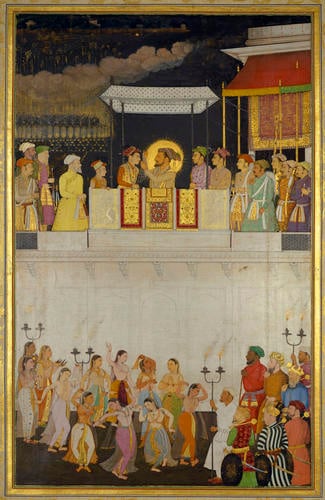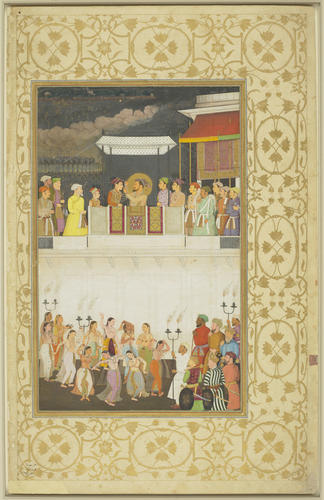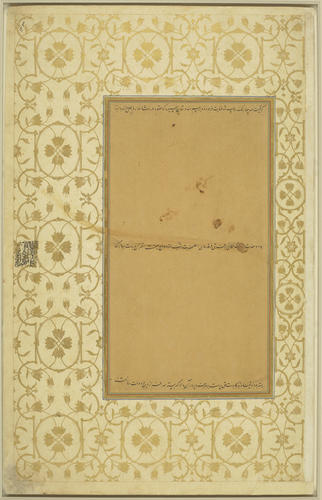-
1 of 253523 objects
Shah-Jahan honouring Prince Dara-Shukoh at his wedding (12 February 1633) c. 1635-50
Painting in opaque watercolour including metallic paints. | 38.8 x 24.1 cm (image) | RCIN 1005025.z

Bulaqi
Master: Padshahnamah پادشاهنامه (The Book of Emperors) Item: Shah-Jahan honouring Prince Dara-Shukoh at his wedding (12 February 1633) c. 1635-50

Bulaqi
Master: Padshahnamah پادشاهنامه (The Book of Emperors) Item: Shah-Jahan honouring Prince Dara-Shukoh at his wedding (12 February 1633) c. 1635-50

Bulaqi
Master: Padshahnamah پادشاهنامه (The Book of Emperors) Item: Shah-Jahan honouring Prince Dara-Shukoh at his wedding (12 February 1633) c. 1635-50



-
Padshahnamah fol. 124v
(plate 25)
The first of two facing paintings depicting the sihra bandi ceremony for Prince Dara Shukoh’s wedding at the Agra Fort on 12 Feb 1633.
The sihra bandi was a Hindu wedding tradition adopted by the Mughals whereby, on the eve of his marriage, a veil (sihra) was fastened around the groom’s forehead to protect him from the evil eye. This painting depicts Shah-Jahan, seated beneath a night canopy decorated with silver stars, fastening the sihra, made of strands of pearls set with rubies and emeralds, around the head of Prince Dara-Shukoh, who wears gold robe of honour. The Padshahnamah texts records that this was the same veil that Shah-Jahan had warn for his own sihra bandi ceremony: 'In accordance with the custom of Hindustan, for good luck His Majesty fastened around the Prince's head the sihra, which consists of strands of lustrous pearls with brilliant rubies and emeralds, and which His Majesty Jannat-Makani [Jahangir] had fastened with his own blessed hand around His Majesty's [Shah-Jahan's] head on the eve of his marriage.'
The event takes place on an upper terrace overlooking the river, with the balcony in front of the Emperor and his sons draped in fine textiles. Beside them, witnessing the event, are important noblemen, including Jafar Khan, Dara-Shukoh’s uncle by marriage. Two men on the far-right hold gifts of a sword, a dagger, and a turban ornament to be presented as gifts to the Prince. Below the terrace are female dancers, dancing barefoot in a circle, each depicted in a different pose of the dance. These women are probably kanchani, members of a professional class of dancers and musicians. According to one contemporary European observer, ‘They were not indeed the prostitutes seen in bazaars, but those of a more private and respectable class, who attend the grand weddings […] for the purpose of singing and dancing. Most of the Kenchens are handsome and well-dressed and sing to perfection…’ (Francois Bernier, p.274). A group of macebearers stand guard watching them.
In the background the artist has painted the magnificent firework display that took place that night, the fireworks taking human, animal and fantastic forms, details of which are just discernible on very close inspection of the upper right of the image. The English traveller, Peter Mundy, who was present in Agra for this event, gave the following description: 'On the Strand by the River side, under the castle wall and the Kinges windowe, there was a place Rayled in, about half a mile in Compasse att least. In it were placed the fireworkes, vizt., first a ranck [row] of great Eliphants, whose bellies were full of squibbs, Crackers, etts. Then a ranck of Gyants with wheeles in their hands, then a ranck of Monsters.'
The artist Bulaqi signed the painting on the wall just below Shah-Jahan, although some of the paint has subsequently flaked off. The very precise details of the golden fireworks and the metallic threads of the textiles suggest that he specialised in illumination.
Bibliography:
Milo Beach and Ebba Koch, King of the world : the Padshahnama, an imperial Mughal manuscript from the Royal Library, Windsor Castle, 1996
Saqib Baburi, Beyond the Akbarnamah: Padshahnamahs and Official Regnal Chronography for Shah-Jahan Padshah (r. 1037/1628-1068/1658), 2010.Provenance
Illustration from a Padshahnamah manuscript formerly in the Mughal imperial library and acquired by Asaf al-Dawlah, Nawab of Awadh, c.1780-90; presented by Saadat Ali Khan, Nawab of Awadh, to George III via Lord Teignmouth in June 1799.
-
Creator(s)
(illustrator)Acquirer(s)
-
Medium and techniques
Painting in opaque watercolour including metallic paints.
Measurements
38.8 x 24.1 cm (image)
58.2 x 36.8 cm (page dimensions)
Category
Alternative title(s)
Shah-Jahan honouring Prince Dara-Shikoh at his wedding (12 February 1633)